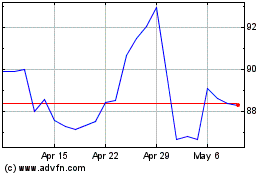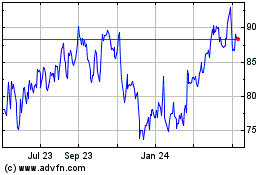By Rebecca Elliott
Chesapeake Energy Corp. filed for bankruptcy protection Sunday
as an oil- and gas-price rout stoked by the coronavirus pandemic
proved to be the final blow for a shale-drilling pioneer long
hamstrung by debt.
Chesapeake is the latest debt-laden U.S. oil and gas producer to
file for bankruptcy, as a coronavirus-induced economic slowdown
saps demand for fossil fuels. More than 200 shale companies may
file for bankruptcy over the next two years if oil and gas prices
stay around current levels, analysts say.
Co-founded in 1989 by the late wildcatter Aubrey McClendon, the
company was early to recognize that horizontal drilling and
hydraulic fracturing could unlock vast troves of natural gas, a
trend that led to a rebirth of American fossil-fuel output and
eventually made the U.S. the top oil producer in the world.
By the end of 2008, the Oklahoma City-based company had drilling
rights to nearly 15 million acres, according to a securities
filing, an empire roughly the size of West Virginia. That vast
footprint once helped Chesapeake earn the title of second-largest
U.S. gas producer.
But Chesapeake's breakneck growth left it highly leveraged, and
it was far slower than many of its peers to pivot to tapping shale
formations for oil, which turned out to be much more lucrative than
gas. U.S. natural gas prices are at their lowest levels in
years.
The result was a painful fall in recent years as Chesapeake
shrank, selling assets to pare debt before winding up in bankruptcy
court.
"They were at the forefront, and they were the most aggressive.
But because of how aggressive they were, it left them unable to
pivot to what ended up being the real moneymaker," said Chris
Duncan, a Brandes Investment Partners director with a say in mutual
funds that own Chesapeake debt.
Chesapeake, which filed for chapter 11 protection with more than
three dozen affiliated companies, listed assets of $16.2 billion
and liabilities of $11.8 billion in its petition with the U.S.
Bankruptcy Court in Houston. The company reached a restructuring
agreement with many of its lenders that is intended to guide the
bankruptcy process and seeks to eliminate some $7 billion in
debt.
"We are fundamentally resetting Chesapeake's capital structure
and business to address our legacy financial weaknesses and
capitalize on our substantial operational strengths," Chief
Executive Doug Lawler said in a statement.
Fallout from the pandemic has already triggered a number of
multibillion-dollar bankruptcies in other industries -- among them
rental car company Hertz Global Holdings Inc., department store
chain J.C. Penney & Co. and pizza chain Chuck E. Cheese -- as
government-mandated closures and social-distancing orders play
havoc with companies' business models.
Wall Street aided U.S. shale companies after the oil-price
downturn of about five years ago, helping many companies stay
afloat. But capital infusions are harder to come by after years of
poor financial performance. U.S. producers raised about $23 billion
in debt and equity financing last year, less than half of the
roughly $57 billion they received in 2016, according to
Dealogic.
With less access to external capital, dozens of smaller shale
players are likely facing bankruptcy in the coming months. U.S.
benchmark natural gas and oil prices are both down more than 30%
year-to-date, settling Friday around $1.50 per million British
thermal units and roughly $38 a barrel, respectively.
At $35 a barrel, roughly 30% of large public U.S. shale
operators are technically insolvent, meaning their net liabilities
exceed their discounted future value, according to consulting firm
Deloitte.
U.S. shale, like so many oil and gas discoveries before it, is
poised to become the province of bigger, better-capitalized
companies.
"If they didn't go into this with a strong balance sheet or at
least a strong line of credit, I think they will not survive," said
Archie Dunham, a former chairman of Chesapeake's board, referring
to the industry broadly. "Hopefully what has happened in the
industry will teach the next generation of leaders and managers and
equity holders that debt is something that you avoid to the extent
that you can."
Mr. McClendon spent most of his early days in the industry as a
landman, or specialist tasked with leasing land for oil and gas
exploration. Under his leadership, Chesapeake was incessant in
scooping up promising drilling prospects.
"It was a race in those days to amass the biggest lease
portfolio that you could. He wanted to be Exxon," said Harrison
Williams, who advised on acreage sales to Chesapeake in the early
2000s. "There just wasn't enough money on God's green earth to
drill it all."
Chesapeake became one of the first stars of the fracking boom.
Mr. McClendon was a charismatic pitchman, talking up the promise of
American natural gas to Wall Street investors and politicians.
The company's success allowed Mr. McClendon to champion the
transformation of Oklahoma's state capital into a more modern
metropolis. He was part of a group that bought the Seattle
SuperSonics NBA basketball team in 2006 and later moved it to
Oklahoma City. The team, now known as the Oklahoma City Thunder,
plays in the Chesapeake Energy Arena. He also indulged in his
passion for fine wine, building a large collection, among many side
pursuits.
But Mr. McClendon's lavish spending eventually proved
troublesome for Chesapeake. In 2008, he had to sell 94% of his
stake in the company, or tens of millions of shares, to satisfy a
margin call. Later, Mr. McClendon's personal financial dealings,
including his use of loans to participate in a company perk that
allowed him a stake in every Chesapeake well, drew shareholder ire.
Investors, including Carl Icahn, ousted him in 2013.
Three years later, Mr. McClendon died in a car crash at age 56,
a day after being indicted by a federal grand jury on accusations
of conspiring to rig the price of oil and gas leases. Mr. McClendon
denied the charge.
By the time Mr. Lawler took the helm of Chesapeake in 2013, the
company was weighed down by some $13 billion in debt. Mr. Lawler
has spent the better part of his tenure selling off pieces of the
vast empire Mr. McClendon amassed to pay off those obligations.
Year by year, he parted with assets from Oklahoma to Louisiana and
a northeast drilling region that Mr. McClendon once called the
"biggest thing to hit Ohio since the plow."
Mr. Lawler deviated from that playbook in 2018, when he struck a
deal valued at about $4 billion, including debt, to buy Texas
driller WildHorse Resource Development Corp., part of an effort to
transform Chesapeake into more of an oil producer.
But the pivot to oil, years after rivals such as EOG Resources
Inc. took such a course, proved too late. Chesapeake's debt still
totaled about $9.6 billion as of the first quarter, S&P Global
Market Intelligence data show, even as its daily output of about
2.9 billion cubic feet of natural gas and oil was down roughly a
third from the company's peak and its footprint of land leased for
drilling was less than a quarter of what it once was.
Under mounting strain this spring as low oil and gas prices
rocked the industry, Chesapeake completed a reverse stock split in
April and warned May 11 that it might not be able to stay in
business, its second such warning in recent months. The company
reported a first-quarter loss of more than $8 billion, led by a
write-down of oil-rich properties in places including Texas and
Wyoming.
Chesapeake also offered 21 high-ranking employees cash-retention
payments totaling about $25 million in exchange for waiving equity
and bonus awards, a move that commonly precedes bankruptcy.
Corporate-governance data company Equilar Inc. said it was unclear
how much each executive would receive. Mr. Lawler's realized pay
through the end of last year totaled more than $48 million, Equilar
said.
As of Friday, Chesapeake's market capitalization was about $116
million, FactSet data show, down from roughly $38 billion at its
2008 peak.
Write to Rebecca Elliott at rebecca.elliott@wsj.com
(END) Dow Jones Newswires
June 28, 2020 18:16 ET (22:16 GMT)
Copyright (c) 2020 Dow Jones & Company, Inc.
Chesapeake Energy (NASDAQ:CHK)
Historical Stock Chart
From Mar 2024 to Apr 2024

Chesapeake Energy (NASDAQ:CHK)
Historical Stock Chart
From Apr 2023 to Apr 2024
